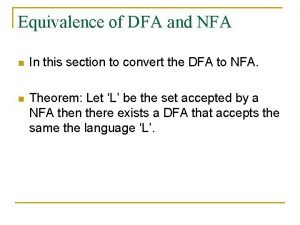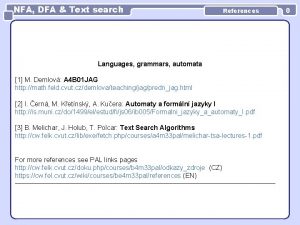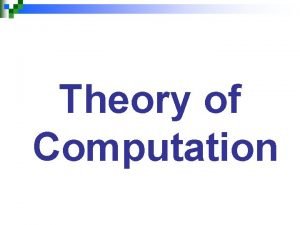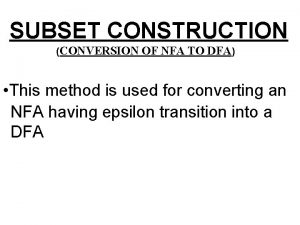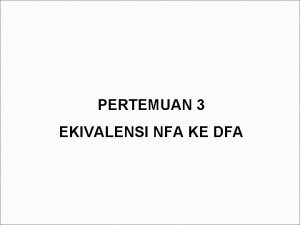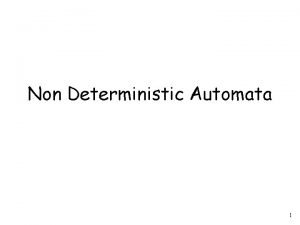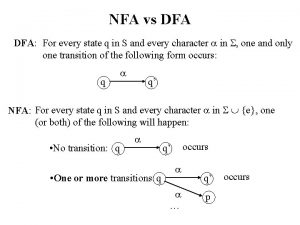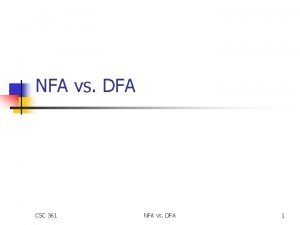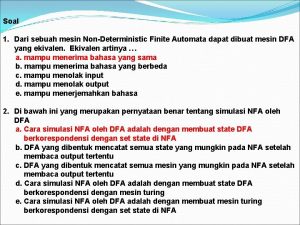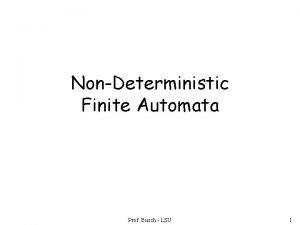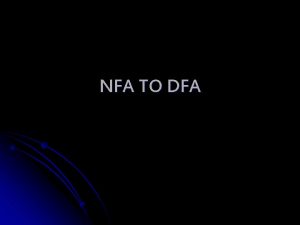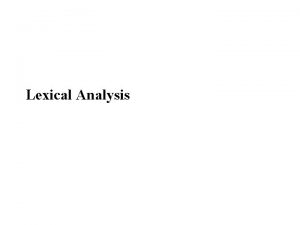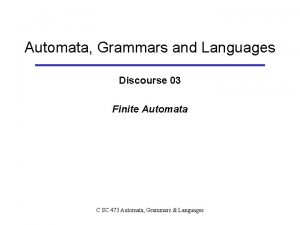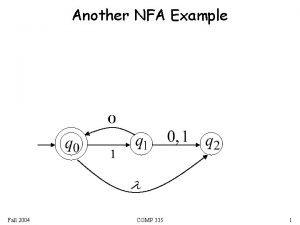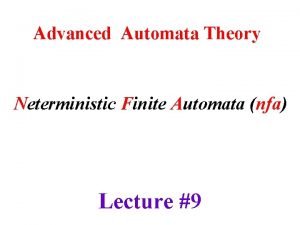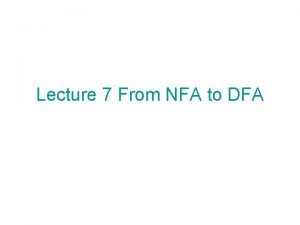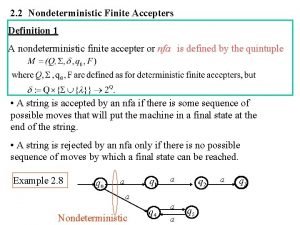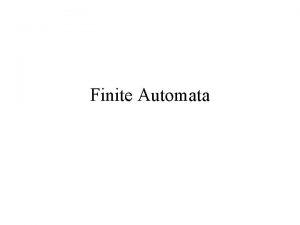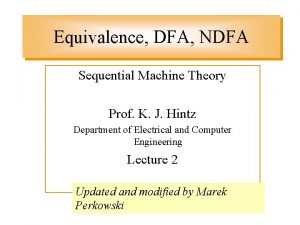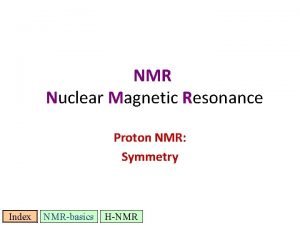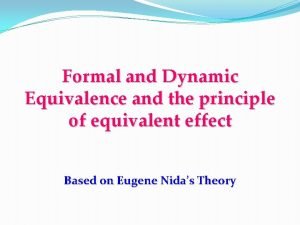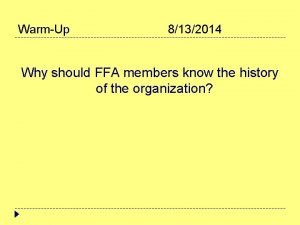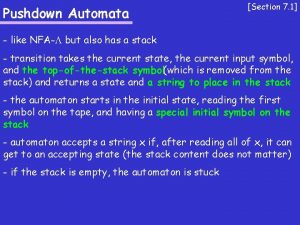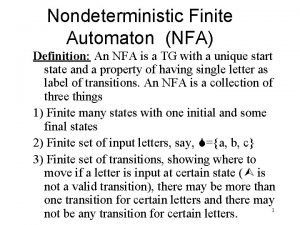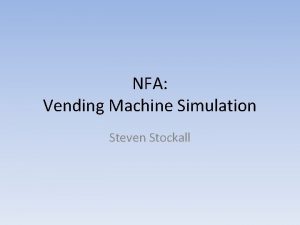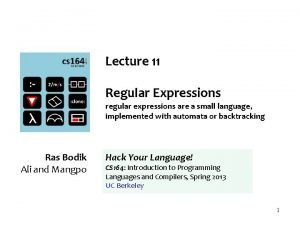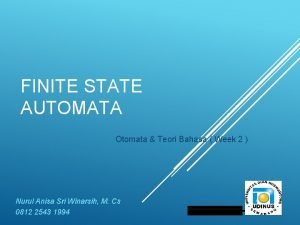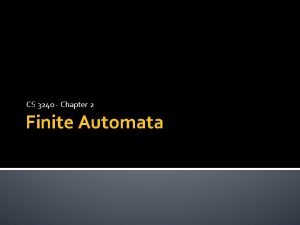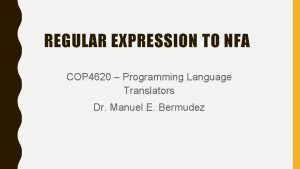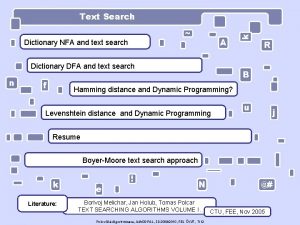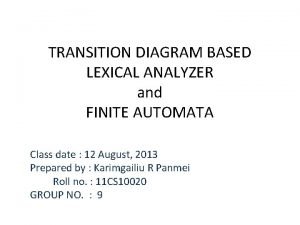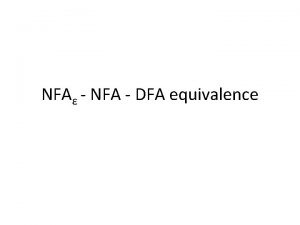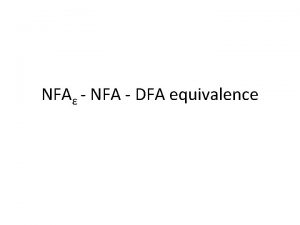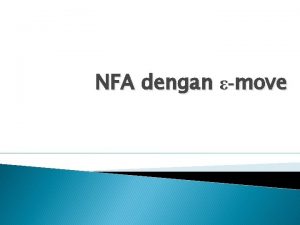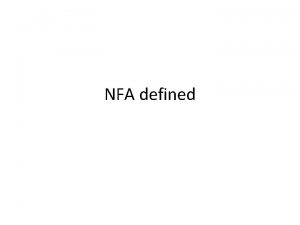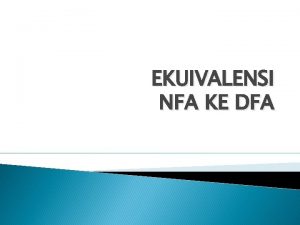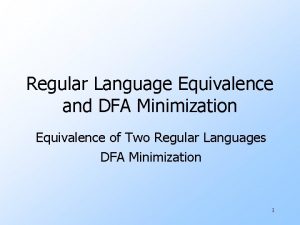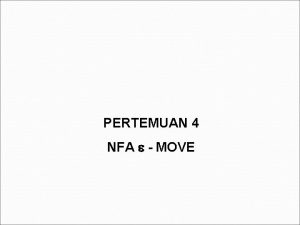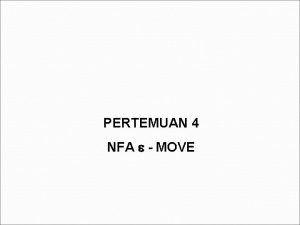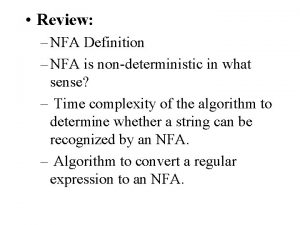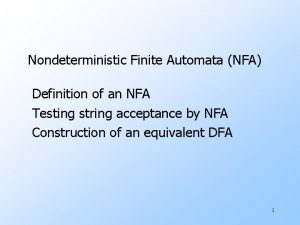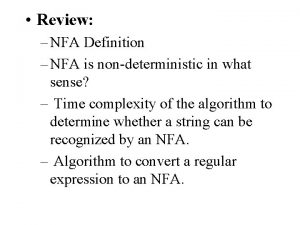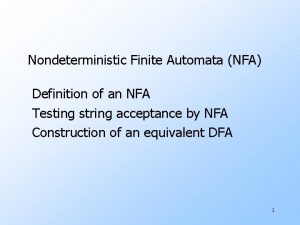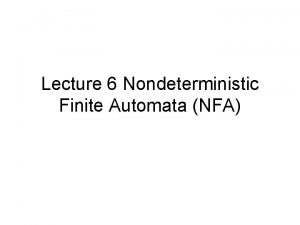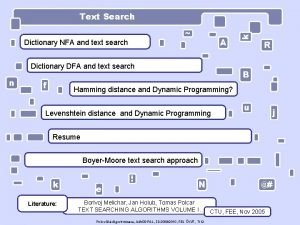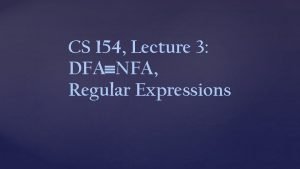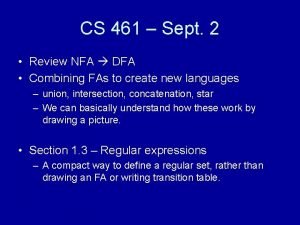Equivalence of DFA and NFA n In this




![n n δ 1([p 1, p 2…pi], a) = [r 1, r 2…rk] If n n δ 1([p 1, p 2…pi], a) = [r 1, r 2…rk] If](https://slidetodoc.com/presentation_image_h/05a68cb6075e18806b3a70ad4a79ef89/image-5.jpg)


![n δ 1( [q 0 q 1], 1) =δ{q 0 q 1}, 1) =δ( n δ 1( [q 0 q 1], 1) =δ{q 0 q 1}, 1) =δ(](https://slidetodoc.com/presentation_image_h/05a68cb6075e18806b3a70ad4a79ef89/image-8.jpg)
![solution 0 Ø [q 0] [q 1] [q 0 q 1] 1 Ø [q solution 0 Ø [q 0] [q 1] [q 0 q 1] 1 Ø [q](https://slidetodoc.com/presentation_image_h/05a68cb6075e18806b3a70ad4a79ef89/image-9.jpg)



![n n n n δ 1( [qs], 1) = [rs] δ 1( [rs], 0) n n n n δ 1( [qs], 1) = [rs] δ 1( [rs], 0)](https://slidetodoc.com/presentation_image_h/05a68cb6075e18806b3a70ad4a79ef89/image-13.jpg)






















- Slides: 35

Equivalence of DFA and NFA n In this section to convert the DFA to NFA. n Theorem: Let ‘L’ be the set accepted by a NFA then there exists a DFA that accepts the same the language ‘L’.

n n n n Proof: let M={Q, ∑, δ, q 0, F) be a NFA accepting the language ‘L’ and to define the DFA M 1={Q 1, ∑, δ 1, q 01, F 1) The final states of ‘M 1’are equal to the subsets of states of ‘M’. Q 1=2 Q. Q has a finite set of states. i. e Q={q 1, q 2…qn} Q 1 has finite set of states accepted by a DFA. Q={q 1, q 2. q 3…. qi} Q 1=[q 1, q 2, q 3…. qi]

i. e equivalent to the single state of DFA corresponds to the set of states in NFA. n δ 1= ([q 1, q 2…qi], a) = [p 1, p 2…pi] if and only if δ = ({q 1, q 2…qi}, a) = {p 1, p 2…pi} It is easy to show by an induction method on the length of the string ‘x’ δ 1(q 01, x) = [q 1, q 2…qi] if and only if δ = ({q 1, q 2…qi}, a) = {p 1, p 2…pi} n

n n n Basis step: The result id trivial for |x|=0 Induction step: suppose length of the string should be length M or less. δ 1(q 01, xa) = δ 1(q 01, x), a) By inductive hypothesis of δ 1(q 01, x) = [p 1, p 2…pi] if and only if δ(q 0, x) = {p 1, p 2…pi}
![n n δ 1p 1 p 2pi a r 1 r 2rk If n n δ 1([p 1, p 2…pi], a) = [r 1, r 2…rk] If](https://slidetodoc.com/presentation_image_h/05a68cb6075e18806b3a70ad4a79ef89/image-5.jpg)
n n δ 1([p 1, p 2…pi], a) = [r 1, r 2…rk] If and only if δ({p 1, p 2…pi}, a) = {r 1, r 2…. rk} To complete the proof we have only to add that δ 1(q 01, x) is in final state F 1. Hence theorem is proved. i. e L(M) =L(M 1).

problem 1 n Construct a DFA from an NFA 0 q 0 *q 1 1 {q 0, q 1} {q 1} Ø {q 0, q 1}

n n n n n To construct a DFA M 1={q 1, ∑, δ 1, q 01, F 1) and accepting the language L(M 1). Q 1=2 Q. Q=2 22=4 δ 1( Ø, 0) =Ø. δ 1( Ø, 1) =Ø. δ 1( q 0, 0) =[q 0 q 1]. δ 1( q 0, 1) =[q 1]. δ 1( q 1, 0) =Ø. δ 1( q 1, 1) =[q 0 q 1] δ 1( [q 0 q 1], 0) =δ{q 0 q 1}, 0) =δ( q 0, 0) U δ( q 1, 0) ={q 0 q 1} U Ø => [q 0 q 1]
![n δ 1 q 0 q 1 1 δq 0 q 1 1 δ n δ 1( [q 0 q 1], 1) =δ{q 0 q 1}, 1) =δ(](https://slidetodoc.com/presentation_image_h/05a68cb6075e18806b3a70ad4a79ef89/image-8.jpg)
n δ 1( [q 0 q 1], 1) =δ{q 0 q 1}, 1) =δ( q 0, 1) U δ( q 1, 1) ={q 0 q 1} U {q 0 q 1} => [q 0 q 1] Set of final states {[q 1], [q 0 q 1]}
![solution 0 Ø q 0 q 1 q 0 q 1 1 Ø q solution 0 Ø [q 0] [q 1] [q 0 q 1] 1 Ø [q](https://slidetodoc.com/presentation_image_h/05a68cb6075e18806b3a70ad4a79ef89/image-9.jpg)
solution 0 Ø [q 0] [q 1] [q 0 q 1] 1 Ø [q 0 q 1] [q 0 q 1]

Problem 2 n Construct a DFA from an NFA 0 1 p {p, q} {p} q {r} r {s} Ø *s {s}

n n n n To construct a DFA M 1={q 1, ∑, δ 1, q 01, F 1) and accepting the language L(M 1). Q 1=2 Q. Q=4 24=16. δ 1( Ø, 0) =Ø. δ 1( Ø, 1) =Ø. δ 1( p, 0) =[pq]. δ 1( p, 1) =[p]. δ 1( q, 0) =[r]. δ 1( q, 1) =[r] δ 1( r, 0) = [s] δ 1( r, 1) = Ø δ 1( s, 0) = [s] δ 1( s, 1) = [s]

![n n n n δ 1 qs 1 rs δ 1 rs 0 n n n n δ 1( [qs], 1) = [rs] δ 1( [rs], 0)](https://slidetodoc.com/presentation_image_h/05a68cb6075e18806b3a70ad4a79ef89/image-13.jpg)
n n n n δ 1( [qs], 1) = [rs] δ 1( [rs], 0) = [s] δ 1( [rs], 1) = [s] δ 1( [pqr], 0) = [pqrs] δ 1( [pqr], 1) = [pr] δ 1( [pqs], 0) = [pqrs] δ 1( [pqs], 1) = [prs] δ 1( [prs], 0) = [pqs] δ 1( [prs], 1) = [ps] δ 1( [qrs], 0) = [rs] δ 1( [qrs], 1) = [rs] δ 1( [pqrs], 0) = [pqrs] δ 1( [pqrs], 1) = [prs] Set of finite states { [s], [ps], [rs], [pqs], [prs], [pqrs], [qrs]}

problem 3 n Construct a DFA from an NFA 0 1 p {q, s} {q} q {r} {q, r} r {s} {p} *s Ø {p}

problem 4 n Construct a DFA from an NFA 0 1 p {p, q} {p} q {r} {q} r {s} Ø *s {s}

Finite Automata with є-closure n n We shall introduce the another extension of FA. NFA is allowed to make a transition with spontaneously without receiving or reading many input symbols.

Contd. .

Example

Transition table

Finite Automata with є-closure

Example

Formal definition of NFA - є closure. n To represent the ∑with NFA A={Q, ∑, δ, q 0, F) where all components have a same interpretations as for a NFA. q q A state in Q. A members of Є U {є} either an input symbol is empty or a set of strings.

E-closure : Definition

Example: Find the є-closure for all the states of given figure

solution n n n ECLOSE(1) ={1, 2, 3, 4, 6} ECLOSE(2) ={2, 3, 6} ECLOSE(3) ={3, 6} ECLOSE(4) ={4} ECLOSE(5) ={5} ECLOSE(6) ={6} ECLOSE(7) ={7}

Inductive definition on δ

Problem 1: consider the following epsilon with NFA and compute the empty closure of each states and find its equivalent to the DFA. є a b c p {q} {p} Ø Ø q {r} Ø {q} Ø *r Ø Ø Ø {r}

n n n n Let A be a NFA with є-closure which has A={Q, ∑, δ, q 0, F) Q={p, q. r} ∑ = {є, a, b, c} To find ECLOSE for all states. ECLOSE(p) = {p, q, r} ECLOSE(q) = {q, r} ECLOSE(r) = {r}






Problem 2: consider the following epsilon with NFA and compute the empty closure of each states and find its equivalent to the DFA. є a b c p Ø {p} {q} {r} q {p} {q} {r} Ø *r {q} {r} Ø {p}

Problem 3: consider the following epsilon with NFA and compute the empty closure of each states and find its equivalent to the DFA. є a b c p {q, r} Ø {q} {r} q Ø {p} {r} {p, q} *r Ø Ø
 Dfa and nfa
Dfa and nfa Language
Language Dfa to nfa
Dfa to nfa Subset construction calculator
Subset construction calculator Contoh soal ekuivalensi dfa ke nfa
Contoh soal ekuivalensi dfa ke nfa Non deterministic automata
Non deterministic automata Nfa dfa
Nfa dfa Dfa vs ndfa
Dfa vs ndfa Buatlah mesin dfa yang ekuivalen dengan mesin nfa
Buatlah mesin dfa yang ekuivalen dengan mesin nfa Dari sebuah mesin nfa dapat dibuat mesin dfa yang
Dari sebuah mesin nfa dapat dibuat mesin dfa yang Unit 2
Unit 2 Contoh soal nfa
Contoh soal nfa Nfa to dfa
Nfa to dfa Nfa to dfa subset construction method
Nfa to dfa subset construction method Convert nfa to dfa
Convert nfa to dfa Nfa to dfa conversion solved examples
Nfa to dfa conversion solved examples Convert nfa to dfa
Convert nfa to dfa Recursive definition of nfa
Recursive definition of nfa Convert the following nfa to dfa:(upload)
Convert the following nfa to dfa:(upload) Nfa to dfa
Nfa to dfa Automata
Automata Equivalence of dfa and ndfa
Equivalence of dfa and ndfa Magnetically equivalent protons
Magnetically equivalent protons Example of dynamic equivalence
Example of dynamic equivalence Equivalence and equivalent effect in translation studies
Equivalence and equivalent effect in translation studies Nfa and ffa merge
Nfa and ffa merge Nfa vs pda
Nfa vs pda Defination of nfa
Defination of nfa Nfa simulation
Nfa simulation Regular expressions
Regular expressions Contoh kasus finite state automata
Contoh kasus finite state automata Finite automata
Finite automata Contoh soal dfa dan jawabannya
Contoh soal dfa dan jawabannya Re to nfa
Re to nfa Nfa text search
Nfa text search Finite automata generator
Finite automata generator
